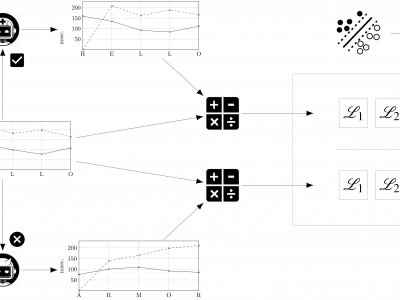Machine Learning
Dataset used in the article "The Reverse Problem of Keystroke Dynamics: Guessing Typed Text with Keystroke Timings". Source data contains CSV files with dataset results summaries, false positives lists, the evaluated sentences, and their keystroke timings. Results data contains training and evaluation ARFF files for each user and sentence with the calculated Manhattan and euclidean distance, R metric, and the directionality index for each challenge instance.
- Categories:
 668 Views
668 Views
Expanding our knowledge of small molecules beyond what is known in nature or designed in wet laboratories promises to significantly advance drug discovery, biotechnology, and material science. Computing novel small molecules with specific structural and functional properties is non-trivial, primarily due to the size, dimensionality, and multi-modality of the corresponding search space. Deep generative models that learn directly from data without the need for domain insight are recently providing a way forward.
- Categories:
 386 Views
386 Views
Twitter is one of the most popular social networks for sentiment analysis. This data set of tweets are related to the stock market. We collected 943,672 tweets between April 9 and July 16, 2020, using the S&P 500 tag (#SPX500), the references to the top 25 companies in the S&P 500 index, and the Bloomberg tag (#stocks). 1,300 out of the 943,672 tweets were manually annotated in positive, neutral, or negative classes. A second independent annotator reviewed the manually annotated tweets.
- Categories:
 11342 Views
11342 Views
# -*- coding: utf-8 -*-
"""
Created on Wed Feb 26 11:19:38 2020
@author: ali nouruzi
"""
import numpy as np
import random
- Categories:
 503 Views
503 ViewsThe S3 dataset contains the behaviour (sensors, statistics of applications, and voice) of 21 volunteers interacting with their smartphones for more than 60 days. The type of users is diverse, males and females in the age range from 18 until 70 have been considered in the dataset generation. The wide range of age is a key aspect, due to the impact of age in terms of smartphone usage. To generate the dataset the volunteers installed a prototype of the smartphone application in on their Android mobile phones.
- Categories:
 2484 Views
2484 ViewsWITH the advancement in sensor technology, huge amounts of data are being collected from various satellites. Hence, the task of target-based data retrieval and acquisition has become exceedingly challenging. Existing satellites essentially scan a vast overlapping region of the Earth using various sensing techniques, like multi-spectral, hyperspectral, Synthetic Aperture Radar (SAR), video, and compressed sensing, to name a few.
- Categories:
 1676 Views
1676 ViewsWITH the advancement in sensor technology, huge amounts of data are being collected from various satellites. Hence, the task of target-based data retrieval and acquisition has become exceedingly challenging. Existing satellites essentially scan a vast overlapping region of the Earth using various sensing techniques, like multi-spectral, hyperspectral, Synthetic Aperture Radar (SAR), video, and compressed sensing, to name a few.
- Categories:
 49 Views
49 Views




